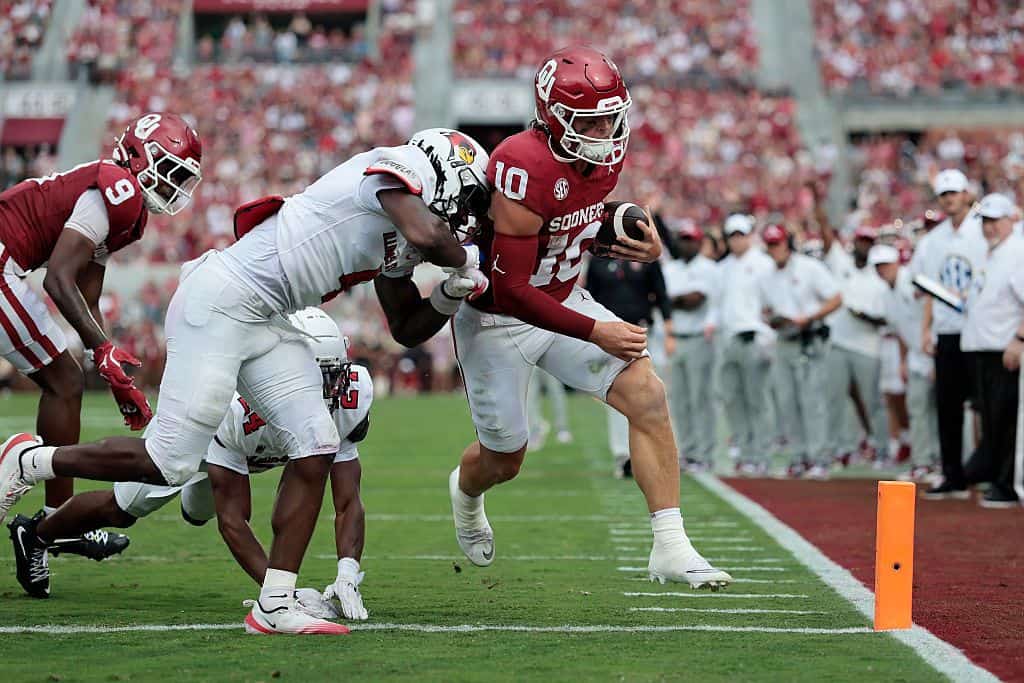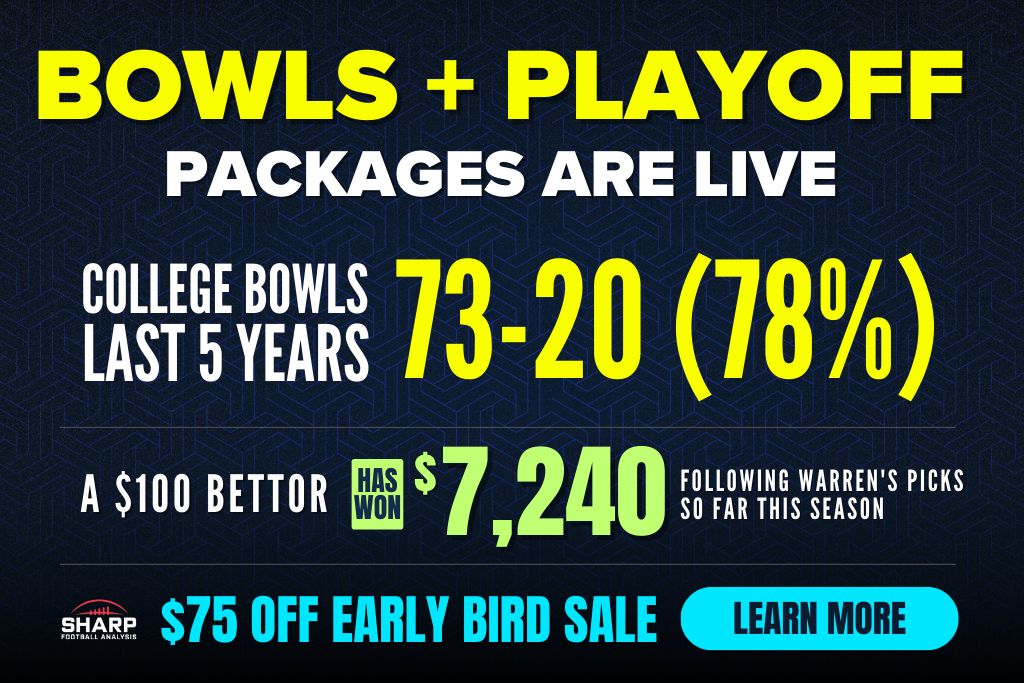This season, I’m breaking down a few of college football's biggest games each week and giving out at least one bet I like from each matchup.
Let’s dive into what appears to be a playoff elimination game between Oklahoma and Tennessee.
Oklahoma vs. Tennessee, current line:
Oklahoma at Tennessee Best Bet Prediction:
Trust the Sooners defense and play Oklahoma against the spread.
- Oklahoma vs. Tennessee, best line: Oklahoma +3.5
» Bet it now at Novig: Oklahoma +2.5 points
When Oklahoma is on Offense
Oklahoma runs a pass-heavy offense under coordinator Ben Arbuckle, relying heavily on quarterback John Mateer, who also played under Arbuckle at Washington State.
The passing attack has been steady throughout the year, but the Sooners have been forced to overcome an inconsistent offensive line due to injuries.
Through eight games, Oklahoma has used four different starting offensive line combinations.
Despite the injuries, Oklahoma’s pass protection has been relatively strong, and the Sooners should hold an edge against Tennessee based on these opponent-adjusted numbers from Sports Info Solutions:
- Oklahoma: ranked 36th in pressure rate allowed
- Tennessee: ranked 81st in pressure rate generated
Arbuckle’s scheme deserves a lot of credit for the low pressure rate, however, and at times, pass protection has still been an issue.
On traditional dropbacks 一 which Mateer uses 57% of the time 一 Oklahoma is allowing a 44.8% pressure rate, ranked 90th.
So Mateer still tends to face pressure at a high rate on passing downs in some critical moments.
Fortunately for Mateer, the Vol defense is unlikely to get after him with any consistency.
Against traditional dropbacks, Tennessee is only generating a 38.8% pressure rate (ranked 83rd) while allowing 8.9 yards per attempt (ranked 109th), per Sports Info Solutions.
Tennessee’s pass defense has been a mess this year, in part due to the lack of a pass rush, but also due to injuries to starting cornerbacks Jermod McCoy and Rickey Gibson.
Not only are the Vols getting picked apart on traditional dropbacks, but they haven’t been any better against quick dropbacks (zero/one-step dropbacks and RPOs).
Against quick dropbacks, Tennessee is allowing 7.0 yards per attempt, ranked 86th.
Due to these struggles, expect to see some big plays from the Oklahoma offense, as the Vols are allowing 20 or more yards on 11.4% of pass attempts, ranked 109th.
In the run game, Tennessee’s defense has been more competitive and likely has an edge based on these opponent-adjusted numbers from Sports Info Solutions:
- Oklahoma: ranked 51st in yards before contact
- Tennessee: ranked 13th in yards before contact allowed
- Oklahoma: ranked 87th in yards after contact
- Tennessee: ranked 81st in yards after contact allowed
Oklahoma’s backfield has been a mess due to the ineffectiveness of transfer Jaydn Ott and injuries to Jovantae Barnes, which has forced freshman Tory Blaylock to take over the bulk of the workload.
Despite the issues, the Sooners' spread offense could potentially have some success against this Vols defense.
Arbuckle excels at spreading the defense out in the run game, creating light boxes for his running backs on 73% of their carries, the highest rate in the SEC.
The Vols should be worried about Arbuckle’s scheme due to their numbers with six or fewer defenders in the box:
- 3.7 yards before contact per attempt allowed, ranked 119th
- 5.3 yards per attempt allowed, ranked 61st
Tennessee might also have to contend with Mateer in the run game, although his involvement has been considerably scaled back since he returned from surgery on his hand.
In three games since his return, Mateer has gained just 76 yards on 27 carries, excluding sacks.
In four games before the injury, Mateer was the Sooners’ leading rusher with 207 yards on 38 carries, excluding sacks.
Tennessee has been vulnerable to mobile quarterbacks this season, allowing 98 yards on 12 carries to Taylen Green of Arkansas and 48 yards on 9 attempts to Georgia’s Gunner Stockton.
When Tennessee is on Offense
Tennessee has been a slightly pass-heavy offense this year under head coach and play caller Josh Heupel, though the rushing attack has always been a critical part of Heupel’s offense as well.
According to Campus2Canton, the Vols throw the ball at a rate 2.4% above expected based on situational data.
Tennessee’s passing attack with Joey Aguilar has been surprisingly strong this season, especially considering Aguilar’s late start learning the offense after transferring from Appalachian State to UCLA and finally Tennessee all within one offseason.
However, Oklahoma will be the best defense the Vols have faced by a wide margin.
The biggest concern for Tennessee is protecting Aguilar, as evidenced by these opponent-adjusted numbers from Sports Info Solutions:
- Tennessee: ranked 66th in pressure rate allowed
- Oklahoma: ranked 11th in pressure rate generated
The rate at which Aguilar has been under pressure is surprising due to the quick pace of Tennessee’s passing attack.
Tennessee uses quick dropbacks on 49% of pass plays, the nation’s eighth-highest rate, which typically negates the pass rush.
However, the Vols have still allowed pressure at a 23% rate on quick dropbacks, ranked 78th.
That’s especially concerning against a Sooners defense that has been dominant against quick dropbacks based on this data from Sports Info Solutions:
- 29% pressure rate, ranked 23rd
- 3.3 yards per attempt, ranked first
One of the reasons for Oklahoma’s success against quick dropbacks has been its ability to limit yards after catch on underneath routes.
On throws five or fewer yards downfield, the Sooners are giving up just 5.6 yards after catch per reception, the sixth-lowest rate.
Tennessee doesn’t run a typical fast-paced offense, however, and Aguilar will take more shots downfield than most quarterbacks relying on quick dropbacks.
Outside the red zone, Tennessee has thrown 15 or more yards downfield 24% of the time, with Aguilar completing an impressive 59% of those throws (ranked fourth).
Oklahoma’s defense ranks 38th by the same metric, allowing a 37% completion rate.
Tennessee should maintain an aggressive approach throwing downfield, however, as there is little risk of a turnover when attacking Oklahoma down the field.
On throws of 10 or more yards, Oklahoma defenders rank 133rd in ball-hawk rate, making a play on the ball just 7.1% of the time, per Sports Info Solutions.
Although Oklahoma’s pass rush does present some challenges, pivoting to a more run-heavy approach in this game likely is not an option.
Check out the run-game matchup based on these opponent-adjusted numbers from Sports Info Solutions:
- Tennessee: ranked 42nd in yards before contact
- Oklahoma: ranked 2nd in yards before contact allowed
- Tennessee: ranked 13th in yards after contact
- Oklahoma: ranked 89th in yards after contact allowed
One of the strengths of Heupel’s scheme is creating light boxes in the run game, which often generates some easy yards on the ground for DeSean Bishop and Star Thomas.
However, Oklahoma leads the nation in run defense with light box, giving up just 2.0 yards per attempt.
The Sooners' success with light boxes stems from their incredible ability to generate early contact.
With six or fewer defenders in the box, Oklahoma has contacted ball carriers at or behind the line of scrimmage 58% of the time, ranked second in the FBS.
This suffocating run defense is the primary reason Oklahoma is forcing its opponents into third-and-long at the nation's highest rate (36%).
And while Aguilar has been effective throwing downfield, the Vols only rank 46th in third-and-long conversion rate.
Final Thoughts on Tennessee vs. Oklahoma Best Bets
The Vols offense has been impressive, but this will be its toughest test, so let’s take Oklahoma against the spread.
With Oklahoma holding an edge in multiple areas on both sides of the ball, taking the points is the obvious choice in this matchup.
The Vols will certainly benefit from the home environment under the lights, but if the Sooners can just avoid costly mistakes, they should cover this spread.



















